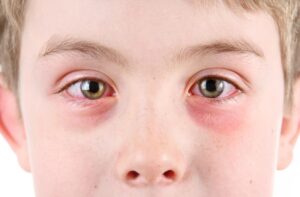Understanding Pink Eye (Conjunctivitis)
Pink eye, medically known as conjunctivitis, is an inflammation of the conjunctiva, the thin, transparent tissue that lines the white part of the eye and the inside of the eyelid. It can be caused by infections (viral or bacterial), allergens, or irritants. Symptoms typically include redness, itching, tearing, and a gritty feeling in the eye. However, several other conditions can mimic these symptoms, leading to misdiagnosis. Understanding these conditions is crucial for appropriate treatment and care.
Common Conditions Misdiagnosed as Pink Eye
1. Allergic Conjunctivitis
Allergic conjunctivitis is often mistaken for infectious pink eye due to similar symptoms such as redness, itching, and tearing. However, allergic conjunctivitis is caused by allergens like pollen, pet dander, or dust mites. Unlike infectious conjunctivitis, it is not contagious. The key difference is the presence of other allergic symptoms such as sneezing, a runny nose, or itchy skin. Treatment typically involves antihistamines and avoiding allergens.
2. Dry Eye Syndrome
Dry eye syndrome occurs when the eyes do not produce enough tears or the tears evaporate too quickly. Symptoms include redness, a gritty feeling, and excessive tearing, similar to pink eye. However, dry eye syndrome is a chronic condition that requires different management strategies such as artificial tears, prescription medications, and lifestyle changes to improve tear production and retention.
3. Blepharitis
Blepharitis is an inflammation of the eyelids that can cause redness, itching, and a burning sensation, often confused with pink eye. It is caused by bacterial infection, malfunctioning oil glands in the eyelids, or other skin conditions such as rosacea. Proper eyelid hygiene, warm compresses, and sometimes antibiotics are necessary to manage blepharitis effectively.
4. Uveitis
Uveitis refers to inflammation of the uvea, the middle layer of the eye. It can cause severe redness, pain, blurred vision, and light sensitivity, which can be mistaken for severe cases of pink eye. Uveitis can be caused by infections, autoimmune disorders, or trauma and often requires prompt medical treatment with anti-inflammatory medications to prevent complications such as vision loss.
5. Subconjunctival Hemorrhage
A subconjunctival hemorrhage occurs when a tiny blood vessel breaks just underneath the conjunctiva, causing a bright red spot on the white of the eye. This condition looks alarming but is usually harmless and resolves on its own without treatment. It does not cause the same symptoms of itching or discharge as pink eye but can be easily misinterpreted as conjunctivitis due to the noticeable redness.
6. Contact Lens-Related Issues
Improper use of contact lenses can lead to eye redness, irritation, and discharge, mimicking the symptoms of pink eye. Conditions such as contact lens-induced conjunctivitis or giant papillary conjunctivitis (GPC) are specific to contact lens wearers. Proper lens hygiene, replacing lenses as recommended, and consulting an eye care professional are crucial for managing these issues.
7. Corneal Ulcers
Corneal ulcers are open sores on the cornea, often caused by infections, injury, or improper contact lens use. Symptoms include severe pain, redness, blurred vision, and discharge, which can be confused with pink eye. However, corneal ulcers are a medical emergency that requires immediate treatment to prevent serious complications, including vision loss.
8. Herpes Simplex Keratitis
Herpes simplex keratitis is an infection of the cornea caused by the herpes simplex virus. It presents with redness, pain, tearing, and sensitivity to light, similar to pink eye. Unlike conjunctivitis, it often affects only one eye and can cause recurrent symptoms. Antiviral medications are necessary to manage this condition and prevent long-term damage to the cornea.
9. Stye or Chalazion
A stye (hordeolum) is a painful, red bump on the eyelid caused by an infected oil gland, while a chalazion is a non-infectious blockage of an oil gland. Both conditions can cause redness, swelling, and discomfort, often leading to confusion with pink eye. Warm compresses and proper eyelid hygiene are effective treatments, but antibiotics may be required for styes.
10. Chemical Exposure
Exposure to chemicals such as chlorine, smoke, or household cleaners can cause eye irritation, redness, and tearing, similar to pink eye. It is important to identify and avoid the source of irritation and flush the eyes with water immediately. Medical attention may be necessary if symptoms persist.
11. Foreign Bodies in the Eye
Foreign bodies such as dust, sand, or metal particles can cause redness, tearing, and a gritty sensation, which can be mistaken for pink eye. It is essential to remove the foreign body safely and seek medical care if the object is embedded or if symptoms do not resolve after removal.
12. Glaucoma
Acute angle-closure glaucoma is a rare but serious condition that can present with red eyes, pain, blurred vision, and nausea, which can be confused with severe conjunctivitis. It occurs when the drainage angle of the eye becomes blocked, leading to a rapid increase in intraocular pressure. This condition requires immediate medical intervention to prevent permanent vision loss.

Proper Diagnosis and Treatment
Accurate diagnosis is crucial for effective treatment. An eye care professional can differentiate between these conditions through a comprehensive eye examination, which may include assessing medical history, conducting a slit-lamp examination, and performing other diagnostic tests as needed. Misdiagnosis can lead to inappropriate treatment, prolonged discomfort, and potential complications.
When to Seek Medical Attention
If you experience persistent or severe symptoms such as intense pain, vision changes, or symptoms that do not improve with standard treatment, it is important to seek medical attention promptly. Early diagnosis and appropriate management are key to preventing complications and ensuring optimal eye health.
Conclusion
Recognizing the conditions that can be commonly misdiagnosed as pink eye is essential for proper treatment and care. Understanding the subtle differences and seeking professional evaluation can help ensure accurate diagnosis and effective management. By being aware of these conditions, individuals can avoid unnecessary treatments and potential complications, leading to better overall eye health.






